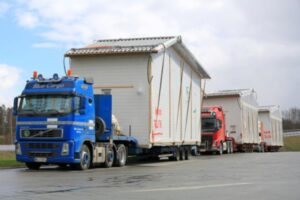
At Outback Transport, we’ve hauled everything from cozy cabins to utility sheds and even small coffee shops across North Idaho, Spokane, and surrounding areas. While “portable” buildings are meant to be moved, the truth is — some are a lot trickier than others.
Moving a portable building isn’t as simple as hitching it to a truck and hitting the road. A lot of variables come into play, and not every structure is ready for the ride. Here’s why some buildings are more challenging to move — and how we make it work anyway.
1. Bigger Buildings, Bigger Challenges
Some portable buildings are small and straightforward. Others? Not so much. We often get called to move large mini-cabins or extended sheds that push the limits of standard transport. Their size and weight can create a logistical puzzle.
Our approach:
We come prepared with heavy-duty skids, trailers, and the experience to maneuver oversized buildings. We’ll evaluate the structure first to make sure it can safely travel, then use the right equipment to balance and move it without damage.
2. Not All Foundations Are Created Equal
Just because a building is “portable” doesn’t mean it was built to be easily removed. Some are anchored down or partially set into a permanent base, which makes a clean lift more complicated.
What we do:
We inspect every job before committing. If the structure is tied to a foundation, we’ll assess whether it can be detached safely. We’ll let you know what prep work is needed — and whether it’s worth the move or not.
3. Accessibility Isn’t Always Simple
Back roads, steep hills, soft ground — if you live in North Idaho or Eastern Washington, you know the terrain can get wild. Tight driveways and off-grid locations can make shed and cabin transport a real test of patience (and skill).
How we handle it:
We’ve learned how to work with the land, not against it. Our drivers know the local roads and what kind of trailer clearance and turning radius we’ll need. We also use pilot cars when necessary for safe road travel with wide or tall loads.
4. Some Structures Just Aren’t Road-Ready
Older buildings or DIY sheds may not have the strength to survive a move — especially if they’ve been sitting for years in snow, rain, or heat. Weak floors, rotting wood, and poor framing all increase the risk of damage.
What we do about it:
We’ll always check structural integrity before moving a building. If repairs are needed before the move, we’ll walk you through the options. Our goal is to protect your investment — not haul something that might collapse mid-trip.
5. Add-ons Can Get in the Way
Over time, sheds and cabins often get customized — porches, wiring, water hookups, skirting, or HVAC systems. These are great for comfort but can seriously complicate transport.
Our process:
We’ll flag anything that needs to be disconnected or removed before we show up. We’ll also explain what we can and can’t move safely. The more we prep ahead of time, the smoother the move.
We Tackle the Tough Ones
At Outback Transport, we’re not just about easy jobs. We’ve built our business on handling the complex moves — the ones other companies won’t touch. We bring the gear, the grit, and the get-it-done attitude to every project.
So, if you’re wondering whether your building can be moved, just ask. We’ll give you an honest answer, assess the situation, and let you know exactly what it’ll take.
Based in North Idaho and servicing everywhere from Grangeville to Spokane, and even parts of Oregon.
Contact us today at 208.490.1482 or visit us online for more information!

Leave a Reply